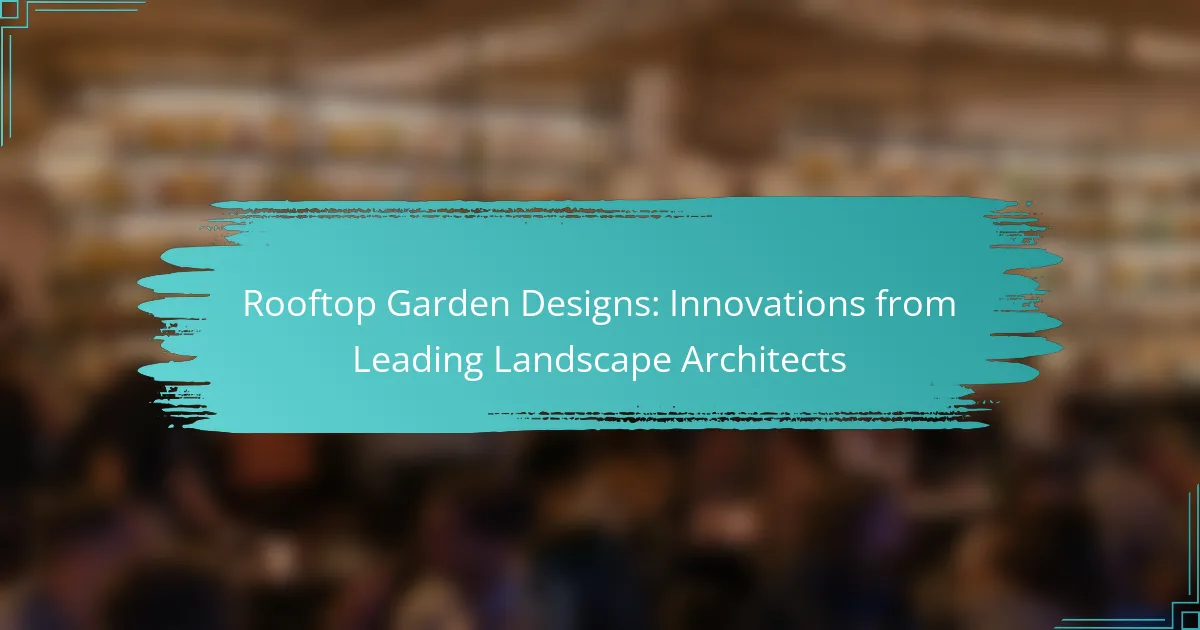Rooftop garden designs from leading landscape architects are transforming urban environments by maximizing green space and enhancing biodiversity. These innovative spaces utilize sustainable materials and technologies, creating functional gardens that improve air quality and foster community engagement. By incorporating efficient irrigation systems and native plants, these designs ensure sustainability while providing aesthetic and health benefits to city residents.
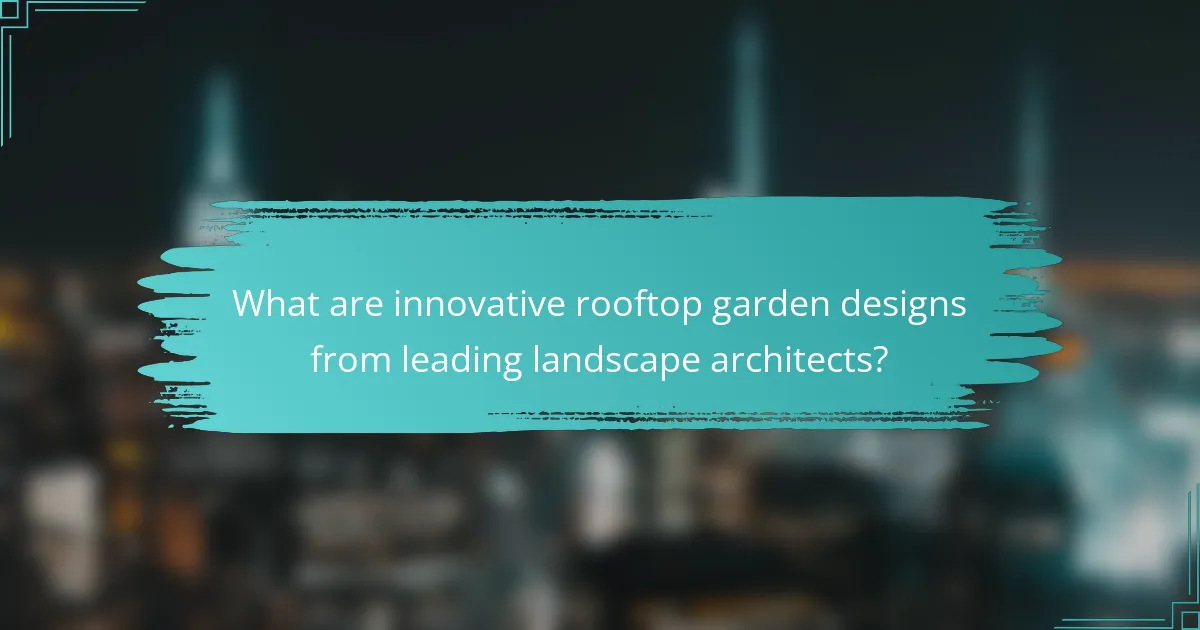
What are innovative rooftop garden designs from leading landscape architects?
Innovative rooftop garden designs from leading landscape architects focus on maximizing green space in urban environments, enhancing biodiversity, and improving air quality. These designs often incorporate sustainable materials and technologies to create functional, aesthetically pleasing gardens that serve both ecological and social purposes.
Green Roof Systems by Patrick Blanc
Patrick Blanc is renowned for his vertical gardens and green roof systems that blend nature with architecture. His designs typically feature a variety of plants arranged in a way that mimics natural ecosystems, providing insulation and reducing urban heat. These systems can be installed on both residential and commercial buildings, often requiring a waterproof membrane and a drainage layer.
When considering a green roof, it’s essential to evaluate the structural capacity of the building, as well as local climate conditions. A well-planned green roof can reduce energy costs by up to 30% and significantly improve stormwater management.
Modular Garden Solutions by Studio Gang
Studio Gang’s modular garden solutions emphasize flexibility and ease of installation. These systems consist of pre-planted modules that can be arranged in various configurations, allowing for customization based on the available space and desired aesthetic. This approach is particularly beneficial for urban settings where space is limited.
Modular gardens can be a cost-effective option, as they often require less maintenance and can be installed without extensive structural modifications. It’s advisable to choose native plants that are well-suited to the local environment to ensure sustainability and lower upkeep.
Urban Farming Concepts by Brooklyn Grange
Brooklyn Grange specializes in urban farming concepts that transform rooftops into productive agricultural spaces. Their designs focus on cultivating vegetables, herbs, and flowers, promoting local food production and community engagement. These farms often incorporate composting systems and rainwater harvesting to enhance sustainability.
Implementing an urban farm requires careful planning, including soil selection, irrigation systems, and crop rotation strategies. Engaging with local agricultural regulations is crucial, as some areas may have specific guidelines regarding rooftop farming practices. By fostering community involvement, these farms can also serve as educational platforms for sustainable practices.
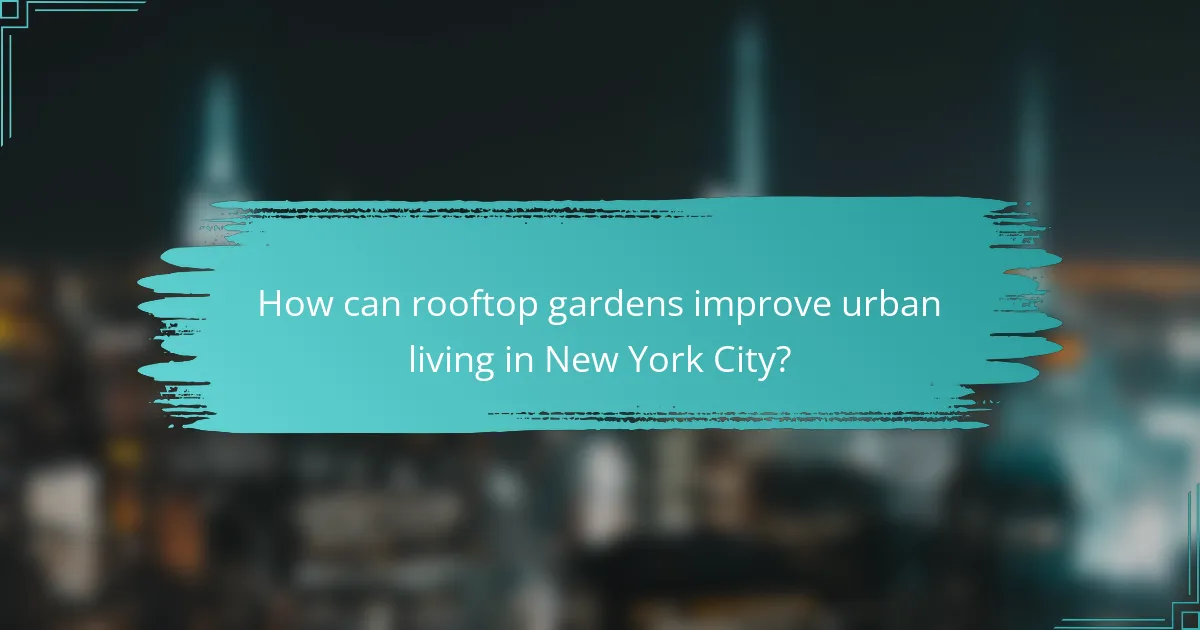
How can rooftop gardens improve urban living in New York City?
Rooftop gardens in New York City can significantly enhance urban living by improving air quality, increasing biodiversity, and fostering community engagement. These green spaces not only provide aesthetic benefits but also contribute to the overall health and well-being of city residents.
Enhanced air quality
Rooftop gardens help improve air quality by absorbing pollutants and carbon dioxide while releasing oxygen. Plants such as ferns, grasses, and flowering species can effectively filter harmful particles from the air, leading to cleaner urban environments.
In densely populated areas like New York City, where air pollution is a concern, incorporating rooftop gardens can lead to noticeable improvements. Studies suggest that urban greenery can reduce airborne particulate matter by up to 30%, making a significant difference in air quality.
Increased biodiversity
Rooftop gardens create habitats for various species, promoting biodiversity in urban settings. By introducing native plants, these gardens attract pollinators like bees and butterflies, which are crucial for ecosystem health.
In New York City, where natural habitats are limited, rooftop gardens can serve as vital refuges for wildlife. Implementing diverse plant selections can support a range of species, contributing to a more resilient urban ecosystem.
Community engagement opportunities
Rooftop gardens can serve as communal spaces that foster social interaction and community building. These gardens provide opportunities for residents to collaborate on gardening projects, host events, or simply enjoy the green space together.
Incorporating educational programs, such as gardening workshops or sustainability initiatives, can further enhance community engagement. By creating a shared responsibility for these green spaces, residents can strengthen their connections to each other and their environment.
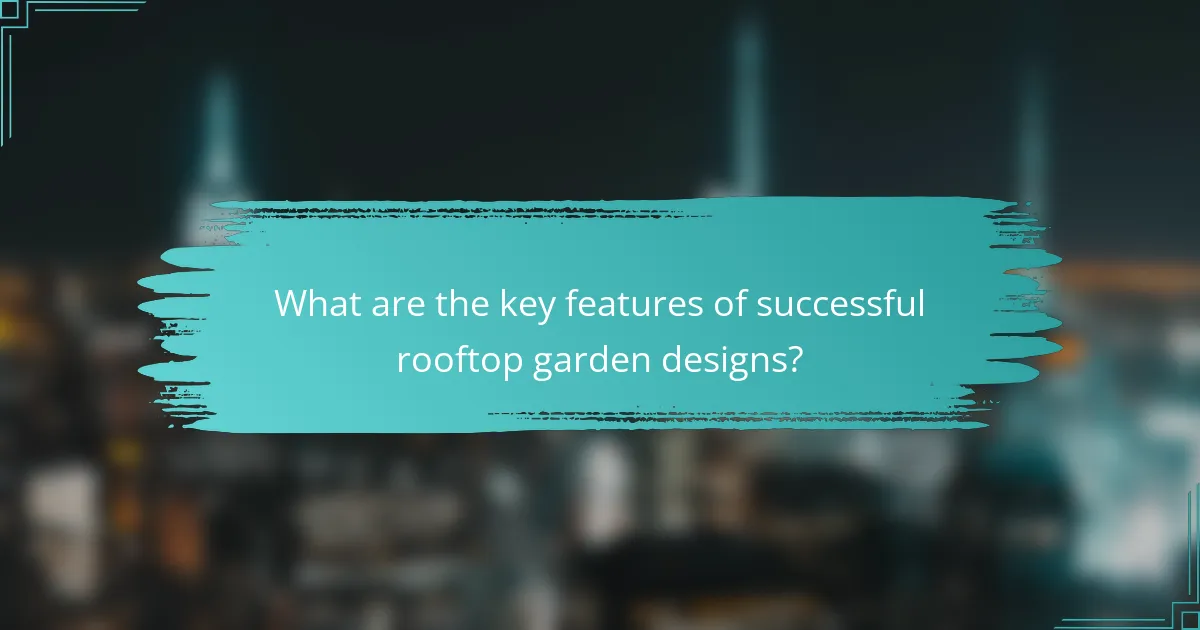
What are the key features of successful rooftop garden designs?
Successful rooftop garden designs incorporate efficient irrigation systems, native plant selection, and multi-functional spaces. These features ensure sustainability, low maintenance, and enhanced usability, making rooftop gardens both practical and enjoyable.
Efficient irrigation systems
Efficient irrigation systems are crucial for maintaining rooftop gardens, especially in urban settings where water conservation is vital. Drip irrigation and smart irrigation controllers can minimize water usage while ensuring plants receive adequate moisture. Consider installing rainwater harvesting systems to collect and utilize natural rainfall, reducing reliance on municipal water supplies.
When designing the irrigation layout, prioritize zones based on plant water needs. Grouping plants with similar requirements can optimize water distribution and reduce waste. Regular maintenance checks are essential to prevent leaks and ensure the system functions effectively.
Native plant selection
Choosing native plants for rooftop gardens enhances biodiversity and reduces maintenance needs. Native species are adapted to local climates and soil conditions, making them more resilient to pests and diseases. They typically require less water and fertilizer compared to non-native varieties, contributing to a more sustainable garden.
Research local flora to identify plants that thrive in your region. For example, in the Mediterranean climate, consider drought-resistant plants like lavender or rosemary. Incorporating a variety of native species can create a visually appealing and ecologically beneficial environment.
Multi-functional spaces
Multi-functional spaces in rooftop gardens maximize usability and enjoyment. These areas can serve various purposes, such as relaxation, social gatherings, or urban farming. Designing spaces that accommodate seating, dining, and gardening allows for diverse activities, enhancing the overall experience.
Consider incorporating features like movable planters or modular furniture to adapt the space for different occasions. Additionally, integrating elements like shade structures or lighting can extend usability into the evening and provide comfort during hot days. Aim for a layout that encourages interaction and engagement with the garden environment.
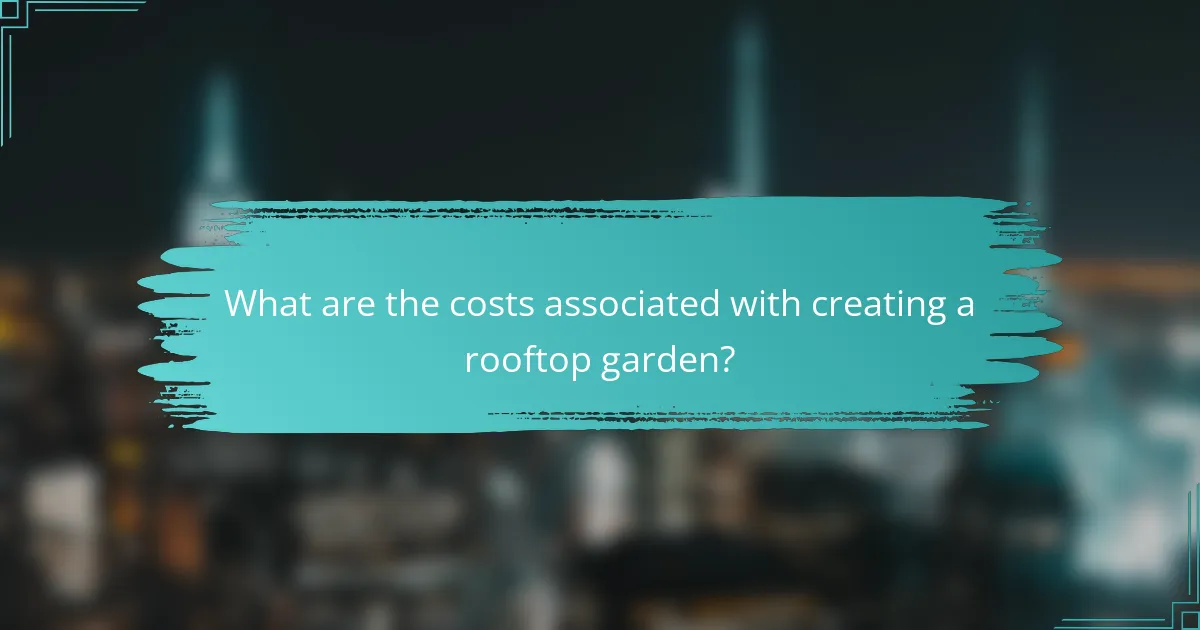
What are the costs associated with creating a rooftop garden?
Creating a rooftop garden involves various costs, including initial installation and ongoing maintenance. Understanding these expenses can help you budget effectively and assess the potential return on investment.
Initial installation expenses
The initial installation costs for a rooftop garden can vary significantly based on factors such as size, design complexity, and materials used. On average, homeowners might expect to spend anywhere from $15 to $50 per square foot for a basic setup, which includes soil, plants, and structural modifications.
Additional expenses may arise from hiring landscape architects or contractors, which can add several thousand dollars to the total cost. It’s crucial to obtain multiple quotes and consider the long-term benefits of professional design versus DIY approaches.
Ongoing maintenance costs
Ongoing maintenance costs for a rooftop garden typically include watering, fertilizing, and seasonal plant care. These expenses can range from $100 to $500 annually, depending on the size of the garden and the types of plants selected.
Regular maintenance is essential to ensure the garden thrives and remains aesthetically pleasing. Hiring a professional service can increase costs but may save time and guarantee expert care.
Potential ROI through energy savings
Investing in a rooftop garden can lead to significant energy savings, potentially offsetting some of the initial and ongoing costs. Studies suggest that green roofs can reduce energy bills by 20-30% by providing insulation and lowering urban heat effects.
Additionally, some regions offer tax incentives or rebates for sustainable landscaping, which can further enhance the return on investment. Evaluating local programs can help maximize financial benefits while contributing to environmental sustainability.
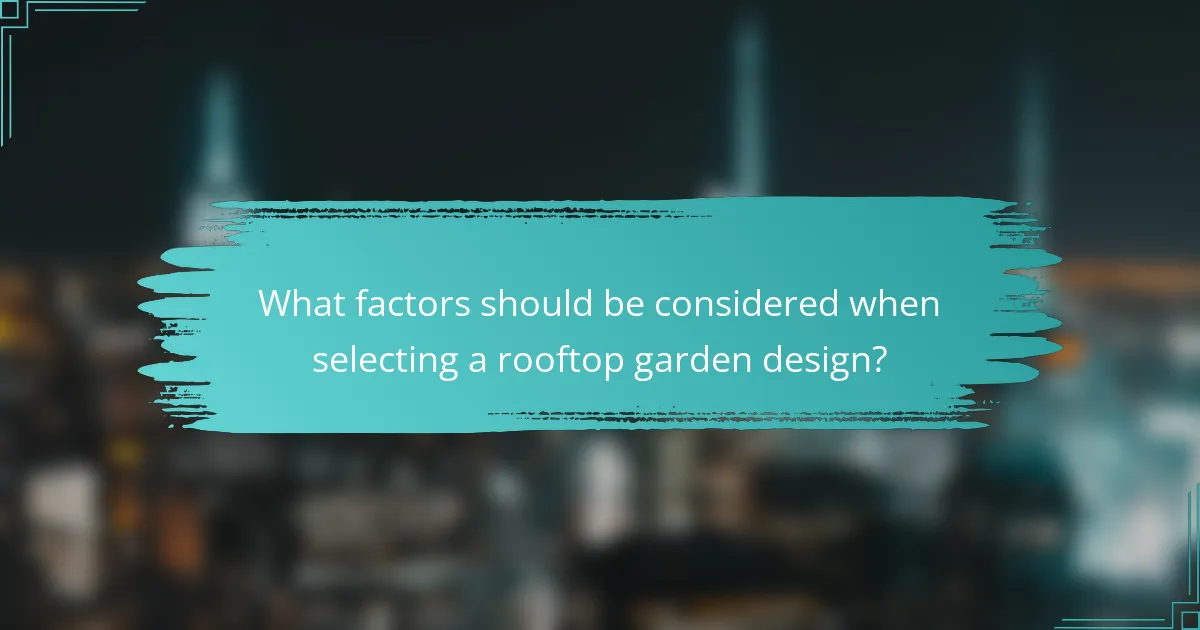
What factors should be considered when selecting a rooftop garden design?
When selecting a rooftop garden design, it’s essential to consider building regulations, weight limits, and local climate conditions. These factors will significantly influence the feasibility and sustainability of your rooftop garden project.
Building regulations and weight limits
Before starting a rooftop garden, check local building regulations to ensure compliance with zoning laws and safety standards. Most municipalities have specific codes regarding structural integrity and load-bearing capacities.
Weight limits are critical; a rooftop garden typically requires a structural assessment to determine how much soil, plants, and additional features can be safely supported. As a general rule, a rooftop can support around 15-20 pounds per square foot, but this varies widely based on the building’s design and materials.
Climate and weather conditions
Climate significantly affects plant selection and garden design. Understanding your local weather patterns, including temperature ranges, rainfall, and sunlight exposure, will help you choose suitable plants that thrive in your environment.
For instance, in regions with harsh winters, consider using hardy perennials and evergreens, while warmer climates may benefit from drought-resistant plants. Additionally, incorporating windbreaks or shade structures can enhance plant survival and comfort for users.
